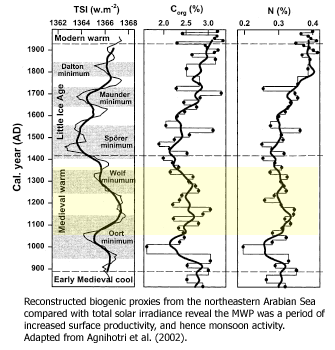Northeastern Arabian Sea
Reference
Agnihotri, R., Dutta, K., Bhushan, R. and Somayajulu, B.L.K. 2002. Evidence for solar forcing on the Indian monsoon during the last millennium. Earth and Planetary Science Letters 198: 521-527.
Reference
Agnihotri, R., Dutta, K., Bhushan, R. and Somayajulu, B.L.K. 2002. Evidence for solar forcing on the Indian monsoon during the last millennium. Earth and Planetary Science Letters 198: 521-527.
Description
The authors used organic C and N concentrations found in a sediment core obtained off the coast of India in the northeastern Arabian Sea (21.8°N, 68°E) as proxies for surface productivity and monsoonal intensity. Their results indicated that the intensity of the Indian monsoon decreased during the Little Ice Age, but increased during the Medieval Warm Period (~ AD 1050-1300). In addition, they found a strong coupling between the biogenic proxies and reconstructed total solar irradiance during the last millennium that was suggestive of a solar control on the intensity of the Indian monsoon and likely the MWP and LIA as well.





